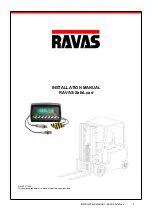
9
Inspection of Forks, Mast and Lift Chains
(See FIGURE 5. and FIGURE 6.)
WARNING
Never work under a raised carriage or forks. Lower
the carriage or use blocks and chains on the mast
weldments and carriage so that they can not move.
Make sure the moving parts are attached to a part
that does not move.
Do not try to correct fork tip alignment by bending
the forks or adding shims. Replace damaged forks.
Never repair damaged forks by heating or welding.
Forks are made of special steel using special proce-
dures. Replace damaged forks.
1. Inspect the welds on the mast and carriage for cracks.
Make sure that the nuts and bolts are tight.
2. Inspect the channels for wear in the areas where the
rollers travel. Inspect the rollers for wear or damage.
3. Inspect the forks for cracks and wear. Check that the
fork tips are aligned (item 1, FIGURE 5.). Check that
the bottom of the fork is not worn (item 8, FIGURE 5.).
4. Replace any damaged or broken parts that are used to
keep the forks locked in position.
5. Check that the lift chains are correctly lubricated. Use
engine oil to lubricate the chains.
6. If the lift truck is equipped with a side–shift carriage
or attachment, inspect the parts for cracks and wear.
Make sure the parts that fasten the side–shift carriage or
attachment to the carriage are in good condition.
7. Inspect the lift chains for cracks or broken links and
pins. (See FIGURE 6.)
8. Inspect the chain anchors and pins for cracks and
damage.
9. Make sure the lift chains are adjusted so that they have
equal tension. If the lift chains need repair or adjust-
ment, it must be done by authorized personnel. See the
section, THE TWO–STAGE MAST, 4000 SRM 445,
for adjustment procedures.
FIGURE 6. CHECK THE LIFT CHAINS
1. WORN PIN
2. CRACKS
3. EDGE WEAR
4. HOLE WEAR
5. LOOSE LEAVES
6. DAMAGED PIN
7. CORROSION
6705
1
2
3
4
5
6
7
SAFETY LABELS
WARNING
Safety labels are installed on the lift truck to give in-
formation about operation and possible hazards. It
is important that all safety labels are installed on the
lift truck and can be read.
Check that all safety labels are installed in the correct lo-
cations on the lift truck. See the PARTS MANUAL or
the FRAME section of the SERVICE MANUAL for
the correct location of the safety labels.
If new labels must be installed, use the following proce-
dure:
WARNING
Cleaning solvents can be flammable and toxic, and
can cause skin irritation. When using cleaning sol-
vents, always follow the recommendations of the
manufacturer.
a. Make sure the surface is dry and has no oil or
grease. Do not use solvent on new paint. Clean
the surface of old paint with a cleaning solvent.
b. Remove the paper from the back of the label. Do
not touch the adhesive surface.
c. Carefully hold the label in the correct position
above the surface. The label cannot be moved
after it touches the surface. Put the label on the




























